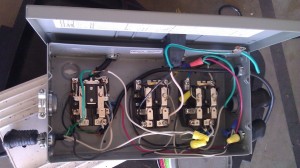
The purpose of this device was to allow two HID bulbs to be ran off of a single ballast, also known as a flip flop. I came across a similar design on the internet and after studying numerous commercially available options, I decided I would rather have the experience of building something a way to obtain a greater understanding of how it worked. After talking with two mentors that both advised me to heed caution while steering me in the right direction, I was ready to get started.
The design process was fairly simple. How many ballast am I wanting to flip-flop? In this instance the number was three. Picking out the proper contactor took a while as finding a store who sold them locally proved to be quite difficult. After spending a beautiful summer morning driving around Sacramento I was finally able to find a retailer, Metro Electronics, who carried the brand of relays I was looking for. Although Metro Electronics did not stock the contactor I needed, it was really nice to be able to look at and touch a shelf full of relays to get a better understanding of how relays work and are sold. While at Metro Electronics I was able to obtain an NTE catalog which showed all of various relays and contactors. With the catalog I was able to trace my finger across the pages as I strived to understand each models difference and the various functions they were suited for. Going with the over engineered approach, I selected the model capable of supporting up to 30 amps.
With the contactors in hand I then went to Home Depot to acquire wire and an enclosure suitable for housing all three of the contactors. This was the first industrial type project I had done by myself, so I was almost clueless about how to wire up the box in a clean and professional manner. It was only after I asked a mentor to look over the flip flop when he burst out in laughter did I realise how ugly of a job I had done. While he told me it was safe, he also explained how it should be a lot cleaner for industrial use and showed me a few examples of the level of quality that is the proper way to install wiring inside of an enclosure.
The implementation of this flip flop has been multi-faceted as sometimes it has been used to flip-flop all three or sometimes only one while using the other two plugs as a convenience junction box. It is ugly and scary, but has provided years worth of work with no issues. I attribute this to fact that it is such a simple design. Overall this project was a great way to gain experience with heavy duty switching systems and taking a project from concept to completion.
